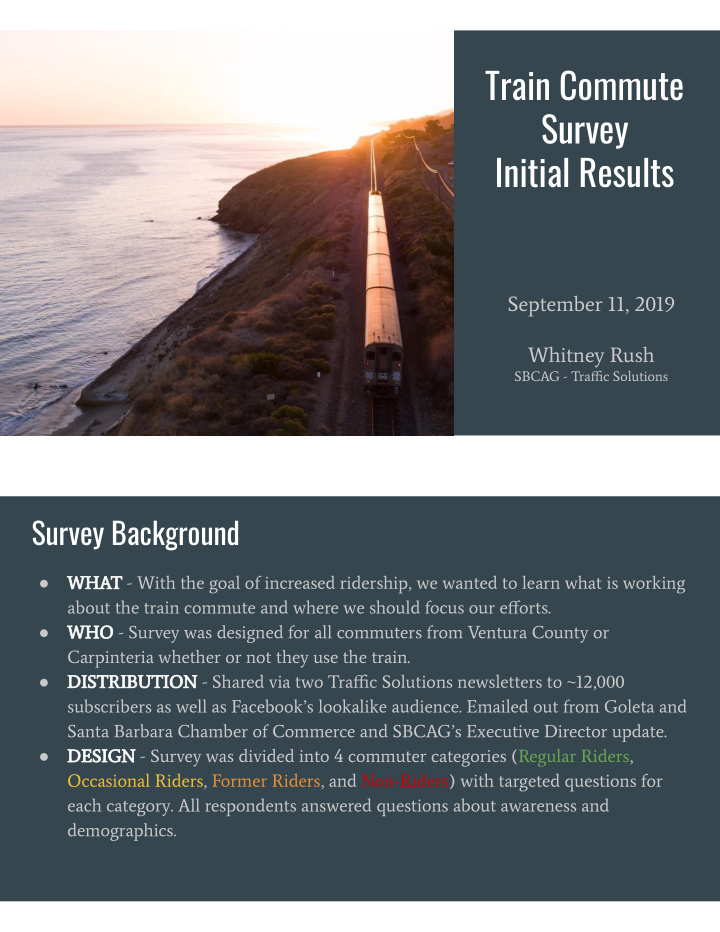



Train Commute Survey Initial Results September 11, 2019 Whitney Rush SBCAG - Traffic Solutions Survey Background WHAT - With the goal of increased ridership, we wanted to learn what is working ● about the train commute and where we should focus our efforts. WHO - Survey was designed for all commuters from Ventura County or ● Carpinteria whether or not they use the train. ● DISTRIBUTION - Shared via two Traffic Solutions newsletters to ~12,000 subscribers as well as Facebook’s lookalike audience. Emailed out from Goleta and Santa Barbara Chamber of Commerce and SBCAG’s Executive Director update. ● DESIGN - Survey was divided into 4 commuter categories (Regular Riders, Occasional Riders, Former Riders, and Non-Riders) with targeted questions for each category. All respondents answered questions about awareness and demographics.
Response How often do you take the Amtrak Pacifi fic Surfl fliner train to and/or from work? Commute = non-riders Survey = former riders = occasional riders Responses = regular riders by zip-code *Note Santa Cruz and Anacapa Island share zip code with city of Ventura.
Regular Riders - n=78 good zip codes, selected train 759. 34% age 55-64 60% male 32% make $150k+ Regular Riders n=78
Awareness of Train Support Programs - 4-way Comparison Of 372 respondents, Amtrak.com, the Amtrak app and Traffjc Solutions site were the most popular locations to receive information. = regular riders n=78 = occasional riders n=47 = former riders n=120 = non-riders n= 113 Why Commuters Do Not Use the Train Occasional, former and non-riders’ reasons they do not ride the train or do not ride it regularly. They were allowed to select all that apply. = occasional riders n=47 = former riders n=120 = non-riders n= 113
Beyond the Schedule - Occasional and former riders who did NOT select schedule as a reason why they no longer ride or do not ride regularly. **Examples of other reasons “I mix train and drving [sic]” “Making a reservation for my bike must be done by phone, and that can take up to 20 minutes!” = occasional riders n=17 “No bike locker in Ventura” “ I work for the SB County - Calle real = former riders n=80 campus and we do not have a shuttle that could take me from work to train station or vis versa.” *commuter used to carpool when they did ride the train Beyond the Schedule - Non-riders Non-riders who did NOT select schedule as a reason why they have never tried the train NOTE: Non-riders, with good zip codes, who marked ‘Connections from the station to my place of work’ as an issue also had only 43% awareness of free MTD shuttles. 22.68% of occasional and former riders listed reliability as a **Examples of other reasons reason they no longer ride the train, compared with this 5.71% “Lot of logistics when in SB to get around. Longer down time.” = non-riders n=70 “takes too long especially if I have to figure out how to get to work from the train station” “No incentive to why would I?”
Female Riders = occasional and former riders n=74 = non-riders n=62 Age 25-34 Ridership = occasional and former riders n=37 = non-riders n=24
Key Takeaways Regular Riders - For those it works for, What we are doing it can be an enormous positive change. Clarifying and advertising workplace connections Occasional Riders - tend to not ride when they need their car for errands or Highlighting reduced commute cost their schedule is variable. for the region Former Riders - Many former riders Educating commuters about the stop taking the train due to reliability Emergency Ride Home program and connections to their workplace. Demonstrating flexible schedule For non-riders, perceived or actual options using VCTC Coastal Express connections to their workplace is the biggest barrier. Employing targeted marketing
Recommend
More recommend